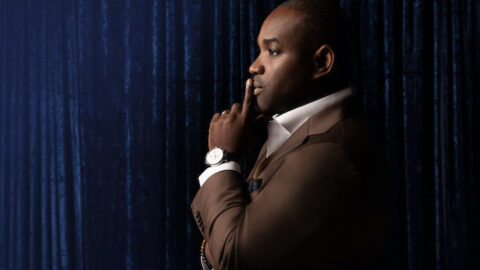The Harlem Renaissance was a time of artistic and intellectual revival for Black Americans in early-20th-century New York. This rich blossoming of music, literature, theater, and other arts has since become a pillar of Black American culture and identity. Nearly a century later, Black artists in the United States are in the midst of a renaissance of their own; following the racial reckoning of 2020, they have leaned into affirming their Blackness and honoring those who came before them through their art.
Rising, the latest album by tenor Lawrence Brownlee, is a testament to this resurgence. Released June 2 on Warner Classics, the album balances canonical works by Robert Owens and Margaret Bonds with newly commissioned songs by six of today’s leading Black composers, who set texts by poets of the Harlem Renaissance. Brownlee’s talent as both a vocalist and a storyteller, in collaboration with the mastery of pianist Kevin J. Miller, shines throughout the album. The tenor’s desire to “create something that speaks not just to our struggles, but to our triumphs,” according to his liner notes, is a compelling throughline.

Damien Sneed’s compositions grapple with choosing happiness and love in spite of what the United States has taken from Black Americans. Beauty That Is Never Old is a melancholic interpretation of James Weldon Johnson’s poem, established by stagnant, somber chords juxtaposed with recurring shimmering flourishes in the upper register of the piano. Brownlee’s gentle, almost mournful voice soothes as he sings about the “haven” of his beholder’s arms.
Jeremiah Evans’ settings of poems by Langston Hughes, Georgia Douglas Johnson, and Arna Bontemps move from quiet acceptance to eerie reflection. The undulating and reposeful April Song encourages the listener to embrace the rain as it “…sing(s) you a lullaby.” Lost Illusions paints adolescence as a still glimmer in time, just like the remnants of an abandoned plantation detailed in Southern Mansion. These remnants come to life in the combination of cold and meditative repeated notes, in the piano’s lower register, with the reserved, mournful color of the vocal line.

Similar to the improvised humming in some Black churches during worship and reflection, Brownlee’s sensual “ah’s” in Brandon Spencer’s Dance of Love (text by Countee Cullen) and atmospheric “ooo’s” in Shawn Okpebholo’s Romance (text by Claude McKay) exemplify his masterful approach to interjections and ability to communicate his artistry without words. Creating a throughline of improvisation, Romance feels like a journey of organized spontaneity with flourishes and bursts of expression. Brownlee’s impressive range makes Joel Thompson’s setting of Hughes’ My People feel like an instrumental cadenza; what begins as an ode to the vastness of the Black experience turns into a display of playfulness and virtuosity.
Jasmine Barnes’ Peace (text by Georgia Douglas Johnson) builds on Brownlee’s desire to seek hope and inspiration. This sweet ballad guides listeners to the tranquility that comes after enduring difficult times. The piano provides a gentle and romantic undertone, carrying the song forward and supporting Brownlee as he floats on top, particularly in his melismatic expansions of the word “peace.” In this place of calm, Barnes uses Claude McKay’s poem Invocation to call on the spirit and music of the ancestors, inviting the originators of the Harlem Renaissance to participate in this contemporary one.

Margaret Bonds’ collegial relationship with Langston Hughes, and her talent as a composer and pianist, made her integral to the Black mecca that was Harlem in the 1930s. Songs of the Seasons, her song cycle featuring Hughes’ poems, was never published. It provides an additional layer of storytelling and depth to this album. Bonds conveys the changing seasons by manipulating texture and character in an unpredictable way. In “Winter Moon,” where one might expect a motionless, static landscape, Bonds keeps the tempo flowing but explores the lower register of the vocalist and piano. Using similar ideas, Bonds begins “Young Love in Spring” with an airy waltz; in “Summer Storm,” she uses a rumbling and driving ostinato to depict thunderstorms. Brownlee’s rebirth theme shines in more than one way: in the sense of moving from fall to summer, and in falling in and out of love.
Although composer Robert Owens was not active during the Harlem Renaissance, he also set texts by American poets, including Countee Cullen. “Sleep,” the last song in his Silver Rain cycle, positions the themes of rest and finality in a solemn atmosphere that feels like a lullaby. Besides serving as a pleasant end to the album, it calls for the peaceful rest that African-Americans so desperately need.
I CARE IF YOU LISTEN is an editorially-independent program of the American Composers Forum, and is made possible thanks to generous donor and institutional support. Opinions expressed are solely those of the author and may not represent the views of ICIYL or ACF.
You can support the work of ICIYL with a tax-deductible gift to ACF. For more on ACF, visit the “At ACF” section or composersforum.org.
























